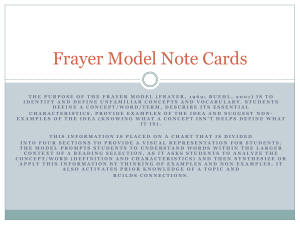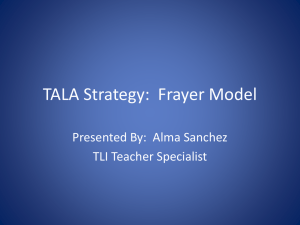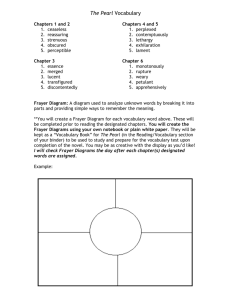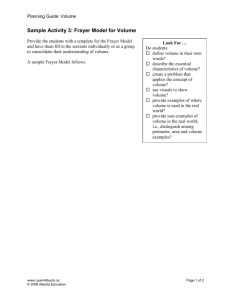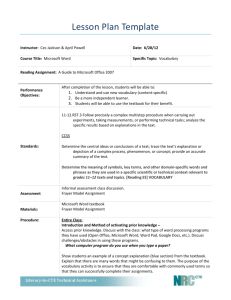Picture - Garcia Middle School
advertisement
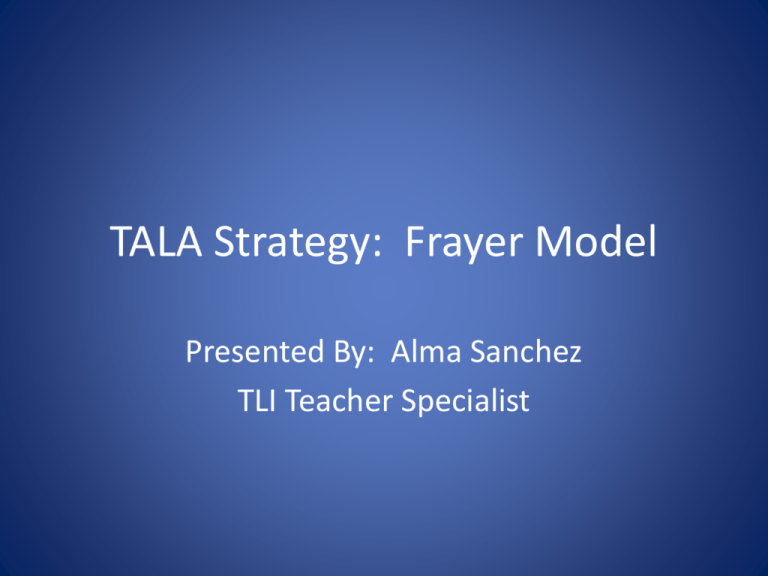
TALA Strategy: Frayer Model Presented By: Alma Sanchez TLI Teacher Specialist Outcomes • Learn how to choose words for use of the Frayer model • Learn how to plan for vocabulary instruction • Understand the importance of quick and accurate word recognition • Learn how to make definitions useful to students • Learn the routine in teaching new vocabulary words to students. • Learn how to modify frayer model for common words How Many Words Should Be Taught? • Students need to learn about 3,000-4,000 words per year to maintain average vocabulary growth (Baumann & Kame’enui, 2004) • Many students with low vocabularies need to learn more words to make progress toward catching up with their peers. • Students must learn through direct instruction and incidentally through exposure and wide reading Planning for Vocabulary • When deciding whether to use the expanded instructional routine, consider whether the word is: – Critically important for comprehension – Frequently encountered – A multiple-meaning word defined differently in other contexts The Importance of Quick and Accurate Word Recognition • Fluent reading (quick, smooth, accurate reading) depends on recognizing many words immediately “at sight” and efficiently identifying unfamiliar words. (Torgesen et al., 2003) • Poorly developed word recognition skills, and a resulting lack of reading fluency, are among the greatest sources of reading challenges. (Rasinski & Padak, 1998; Torgesen et al., 2003) • Concentrating on identifying words reduces the amount of concentration that can be devoted to comprehension. (National Institute of Child Health and Human Development, 2000; Samuels, 2002) Making Definitions Useful to Students • Looking up words in the dictionary is not effective for helping students learn new words. (Scott & Nagy, 1997) • Teaching students only formal definitions does not significantly or reliably improve comprehension. (Baumann & Kame’enui, 1991; Stahl & Fairbanks, 1986) • It is more useful to explain the vocabulary words in simplified, natural English terms before a reading… (Beck, McKeown, & Kucan, 2002) • …and to use formal dictionary definitions after the word has been encountered in text. (Nist & Olejnik, 1995) Routine in Teaching New Vocabulary Words to Students 1. Select the words to teach – Select words for your unit that will be taught 2. Pronouncing and defining the words – Pronounce the word for the student(s) and have them repeat the pronunciation with you – Provide a student friendly definition of the word and check for understanding (some words may be cognates) 3. Generating examples and nonexamples Making Examples and Nonexamples Useful • • • • Closely related to topic and characteristics Synonyms and antonyms Concrete Personally or culturally relevant Frayer Model: Language Arts Definition A writer’s account or memories of true events in his or her life Characteristics •Does not always tell about a person’s entire life •Includes one or more lifechanging events •Usually told in the 1st person •Nonficiton •A type of autobiography Memoir Examples Nonexamples •A short story about the day I broke my •A short story about turning into a arm superhero •A book the President of the United States •A book an author writes about how well writes about how he dealt with a national the President handled a national crisis crisis •A fictional diary of a teenager who is •A diary kept by a child living in a war having trouble at school zone Frayer Model: Math Definition Characteristics A closed, plane figure made up of three or more line segments Examples •Square •Pentagon •Parallelogram •Quadrilateral •Rhombus •Irregular nonagon •Closed •Made of line segments •Three or more sides •Two-dimensional polygon •Ray •Oval •Pyramid •Cylinder •Disk Nonexamples Frayer Model: Science Definition A characteristic of matter that can be seen, felt, heard, smelled, or tasted Examples •Color •Texture •State (solid, liquid, gas) •Boiling point •Odor Characteristics •Can be measured •Describes an object •Information that can be observed without changing the matter into something else Physical property Nonexamples •The way a material behaves in a chemical reaction •Chemical properties •Can be observed only when one substance changes into a different substance •flammability Frayer Model: Social Studies Definition People moving from one place, region, or country to another Characteristics •Involves a major change (long distance or large group) •Could be forced by natural disaster, economy, warfare •Could be a choice because someone wants a different climate, job, or school •Permanent or semi-permanent not temporary Human migration Examples Nonexamples •Move from Dar el Salam in Tanzania to •People staying in one place all their lives Zanzibir •Geese flying form Canada to Mexico •People many years ago walking/floating •Someone from El paso, Texas, going across the Bering Strait from Russia to Juarez, Mexico, for the day North America •Driving from a home in the suburbs to a •People moving from rural areas in the job in the city southern United States to cities in the North Frayer Model: Modified for Special Populations Definition Sentence •The animal walked across the field. Any living things that are not a plant or a human Synonym/Antonym Pig/cerdo Plant/planta Animals/animales Picture Useful Web Sites • Student –friendly definitions http://www.oup.com/elt/catalogue/teachersites/oald7/?cc=global • Idioms http://dictionary.cambridge.org/results.asp?dict=A • Math terms http://www.mathwords.com/
